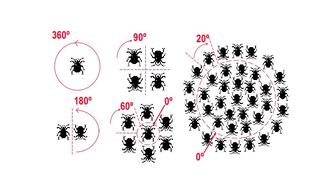Genetics
Global Medicalization Has Come, With Selfish Herd Immunity
The Planetary Hospital was predicted by W. D. Hamilton 20 years ago.
Posted March 20, 2021 Reviewed by Lybi Ma
I wrote about W. D. Hamilton in the first of these posts, where I credited him with being the inspiration of the imprinted brain theory—not to mention with having intuited the diametric model of the mind. His tragic death in 2000 robbed us of whatever further contributions he might have made to science, but not before he had written a remarkably accurate prediction which the current crisis has dramatically highlighted, entitled "The Hospitals Are Coming":
Over the years of my working life I have been slowly developing a paranoia about hospitals. The growth of hospital buildings and all the infrastructure of clinics, pharmacies, the increasing domination of our universities by medical schools associated with huge hospitals all over the developed world, the unending love affair the public have (or are browbeaten to have) with medicine through the TV screen plays on doctors and on hospital life, accelerant birthing by Caesarean section, the indefinite increase of pharmacies even in the Third World, the accompanying increase of our everyday pills that tumble from every bathroom cabinet—all these matters combine to tell us how we are heading. Happy in our progress for the present, like children on a fairground roller-coaster, prattling of the genetic castles to come, we skim onward, uninformed, into the bowels of a great Planetary Hospital of the new millennium. My dread is even worse. It concerns how, by the time our joyride ends, we will realize that we have come into the concrete heaven of our TV dreams but only at basement level.
—Or perhaps as we might say today, lockdown level. Furthermore, and aptly in view of my previous post on the epigenetic role of mitochondria, he adds that:
Increasingly electronic upper and “admin” levels in my “Hospital” would look after us in much the same way as the genome of the eukaryote maintains a remnant genome, sufficient for the purposes that the overarching nuclear-ruled whole requires, in the form of its one-time bacterial allies now going by names such as mitochondria and chloroplasts. Were the bacteria perhaps lured into the eukaryote cells by chemical temptations analogous to our “hospital “TV dramas? Were promises held out to them how grand, dramatic, and safe life would be once they are “inside,” promises of how wonderful would be the biochemical machines they could play with, and what dizzying and expert communication they would see flying by them on all sides? Were they told how they would be borne aloft in moving palaces—humble denizens of soil and slime no longer nor even of merely stationary stromatolites. There in the new palaces they would be fed, advised and cosseted by the wisest of guides and companions—chromosomes out of nuclei. Wow, all this for free! A millionaire’s life on a cruise ship and all for nothing. So the offer to the symbiont may have seemed at first.

In an earlier post, I argued that, to the extent that we might be a self-domesticated species, our ancestral mothers might be seen as our domesticators. Here Hamilton suggests a compelling modern alternative:
A genuinely superhuman organization like this imagined and exemplary Planetary Hospital is perhaps able continually to recreate and maintain us. It will be for such of us, at least—mites within its bowels—as the organization thinks it needs; for the rest it will soon find excuses for their dying out, just as we do for domestic animals that already we have forced into the plight that I predict.
But even Hamilton would have been astonished to learn that in 2020, British people were seen to applaud their National Health Service from their doorsteps once a week; that official posters like that illustrated would appear; and that health service workers would have priority over all others in shops and on public transport.
Hamilton was also the author of "Geometry of the Selfish Herd," a paper in which he set out to refute the top-down, holistic, good-for-the-group thinking of previous writers as neither a necessary nor likely explanation of grouping behaviour. On the contrary, Hamilton developed an individualistic, multi-dimensional mathematical model which is more simply represented in the figure.

In two dimensions, a lone individual is vulnerable to attack from all sides, but when standing next to a neighbour is only vulnerable to attack from one side (left). A cluster of 4 has angular vulnerability halved again: 90º. A cluster of 7 reduces the vulnerability of the 6 on the outside to 60º and allows 0º vulnerability to the individual in the centre (centre). In a larger group, the majority have 0º vulnerability and that of those on the perimeter is minimized (right). Indeed, the model also works in one dimension: time. Female wildebeest on the African plains all give birth within a day or two of one another so that the chances of any individual female's calf being consumed by the local predators are minimised: what you could call selfish herd immunity.
Hamilton entitled the essay which introduces this paper in his collected works, Panic Stations, and illustrates it with a picture of a dog herding sheep. Sheep bunch together the moment they see a dog, and they bunch even more closely when they hear the dog bark, as Hamilton points out. In today’s world, people practise the opposite of bunching, social distancing, for the same reason: Fear. Indeed, as the illustrated WhatsApp traffic revealed in March 2023, members of the British government openly wanted to "frighten the pants of everyone with the new strain" to "get proper bahviour change."

Social distancing isolates individuals, and Hamilton’s model of group behaviour, as the figure illustrates, is an individualistic one: it emphatically does not rely on any invocation of a “herd instinct” or empathic response to others who may be in a similar plight. On the contrary, it is based purely on self-interest in the most basic of all behaviours: self-preservation in the face of danger. Indeed, perhaps this explains why so many Western societies (such as the UK), with their individualized, rather than collectivized, solidarity should have shown such ready compliance with lockdown laws. More traditional groups, with stronger social networks and greater collective solidarity, might be predicted to be less compliant.
Critics of Western liberalism often cite its individualism as its worst vice, but however that may be, what you might in the present crisis call selfish herd immunity as argued here might explain the odd fact that those who see themselves as the most liberal have tended to be most accepting of lockdowns and those who have not have been branded as right-wing reactionaries. At the very least, this way of looking at things nicely fits my description of modern times as the Age of Asperger. Like cats, modern Western people may not be easy to herd into large, cohesive social groups, but they can be scattered by fear.
References
Hamilton, W.D., The Hospitals Are Coming, in Narrow Roads of Gene Land: The Evolution of Sex. The Collected Papers of W. D. Hamilton. Vol. 2. 2001, Oxford: W. H. Freeman/Spektrum. pp. 449-510.
Hamilton, W.D., Panic Stations, in Narrow Roads of Gene Land: Evolution of Social Behaviour. The Collected Papers of W. D. Hamilton. Vol. 1. 1996, Oxford: W. H. Freeman/Spektrum. pp. 229-252




